

Elearning & Digital Cultures. eLearning Tools.
The Teacher Scream. 2014-General-Guide-to-Writing-and-Study-Skills.pdf. Pub_e-learning_guidebook.pdf. Dalziel.pdf. Effectivepracticeelearning.pdf. An absolutely riveting online course: Nine principles for excellence in web-based teaching. Jim Henry Jeff Meadows Authors Jim Henry is an Assistant Professor in the Faculty of Education at the University of Lethbridge.

Correspondence regarding this article can be sent to: jim.henry@uleth.ca Jeff Meadows is a sessional instructor in the Faculty of Education at the University of Lethbridge. Abstract: This article explores excellence in web-based teaching. Un cours en ligne absolument captivant : Neuf principes pour l’excellence en enseignement sur le Web Résumé : Cet article explore l’excellence en enseignement sur le Web. Introduction Like many faculties, our online and blended course offerings have increased significantly over the past few years (Ellis & Hafner, 2003; Moskai, Dziuban, Upchurch, Hartman, & Truman, 2006; Oliver, 1999; Orde, et al., 2001; Steinweg, Trujillo, Jeffs, & Warren, 2006). One thing that most tend to agree on is that online education is here to stay. Some of the answers came to mind immediately; others came with additional exploration.
FedUni-General-Guide-to-Referencing-2014.pdf. Brookfield_summary.pdf. GarrisonKanuka2004. 21st Century Curriculum & Instruction. Blended Learning in Higher Education: Framework, Principles, and Guidelines - D. Randy Garrison, Norman D. Vaughan. This groundbreaking book offers a down-to-earth resource for the practical application of blended learning in higher education as well as a comprehensive examination of the topic.
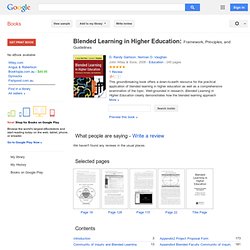
Well-grounded in research, Blended Learning in Higher Education clearly demonstrates how the blended learning approach embraces the traditional values of face-to-face teaching and integrates the best practices of online learning. This approach has proven to both enhance and expand the effectiveness and efficiency of teaching and learning in higher education across disciplines. In this much-needed book, authors D. Randy Garrison and Norman D. Vaughan present the foundational research, theoretical framework, scenarios, principles, and practical guidelines for the redesign and transformation of the higher education curriculum. Conole_fill_learning_design_toolkit.pdf. Best practices for blended learning. Teaching a blended course starts with a re-examination of the intended learning outcomes of the course.
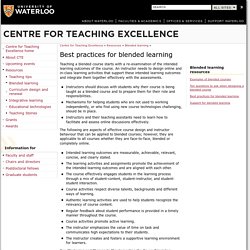
An instructor needs to design online and in-class learning activities that support these intended learning outcomes and integrate them together effectively with the assessments. Instructors should discuss with students why their course is being taught as a blended course and to prepare them for their role and responsibilities. Mechanisms for helping students who are not used to working independently, or who find using new course technologies challenging, should be in place. Blended_learning_whitepaper_web.pdf. Blooms Digital Taxonomy v2.12. Home - Learning Designs - Products of the AUTC project on ITC-based learning designs.
Case story: The perfect blend. Distance learning is not only the domain of the arts and sciences.
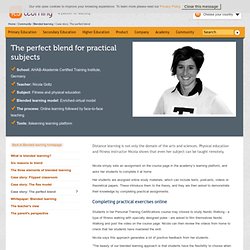
Physical education and fitness instructor Nicola shows that even her subject can be taught remotely. Nicola simply sets an assignment on the course page in the academy’s learning platform, and asks her students to complete it at home. Her students are assigned online study materials, which can include tests, podcasts, videos or theoretical papers. These introduce them to the theory, and they are then asked to demonstrate their knowledge by completing practical assignments.
What is Blended Learning? Blended courses (also known as hybrid or mixed-mode courses) are classes where a portion of the traditional face-to-face instruction is replaced by web-based online learning.
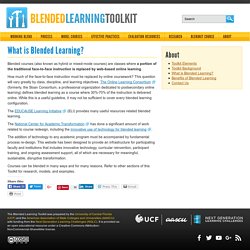
How much of the face-to-face instruction must be replaced by online coursework? This question will vary greatly by class, discipline, and learning objectives. The Online Learning Consortium (formerly, the Sloan Consortium, a professional organization dedicated to postsecondary online learning) defines blended learning as a course where 30%-70% of the instruction is delivered online. While this is a useful guideline, it may not be sufficient to cover every blended learning configuration.
The EDUCAUSE Learning Initiative (ELI) provides many useful resources related blended learning. The National Center for Academic Transformation has done a significant amount of work related to course redesign, including the innovative use of technology for blended learning. Search inside Scoop.it. Blended Learning – Cutting Edge Or A Double-Edged Sword? Excellent presentation provides thorough overview of process, tools, and lessons learned in university’s implementation of blended learning curriculum.
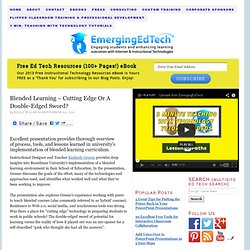
Instructional Designer and Teacher Kimberly Greene provides deep insights into Brandman University’s implementation of a blended learning environment in their School of Education. In the presentation, Greene discusses the goals of the effort, many of the technologies and approaches used, and identifies what worked well and what they’ve been working to improve. The presentation also explores Greene’s experience working with peers to teach blended courses (also commonly referred to as ‘hybrid’ courses). Resistance to Web 2.0, social media, and synchronous tools was strong. Was there a place for “cutting edge” technology in preparing students to work in public schools? Following is an overview of some of the presentation’s key points: Efforts to prepare faculty (71 fulltime and 1400 adjuncts) included: About Kelly Walsh. Infographic: The Flipped Classroom. 8 Great Free Digital Presentation Tools For Teachers To Try This Summer.
A mix of web apps that can help you make presentations that are fun, eye catching, and engaging (great for students too)!
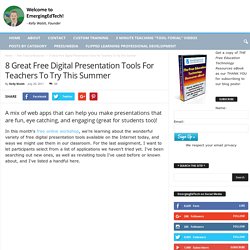
In this month's free online workshop, we're learning about the wonderful variety of free digital presentation tools available on the Internet today, and ways we might use them in our classroom. For the last assignment, I want to let participants select from a list of applications we haven't tried yet. I've been searching out new ones, as well as revisiting tools I've used before or known about, and I've listed a handful here.
This interactive image is an example of a Glogster “poster” I tossed together in about 25 minutes, without any previous knowledge of using the tool. Note the different functionality for video and images – click an image to see it zoom and straighten for a better view, and the videos clips actually play! If there are other free digital presentation tools that you like to use, please comment and let us know about them!